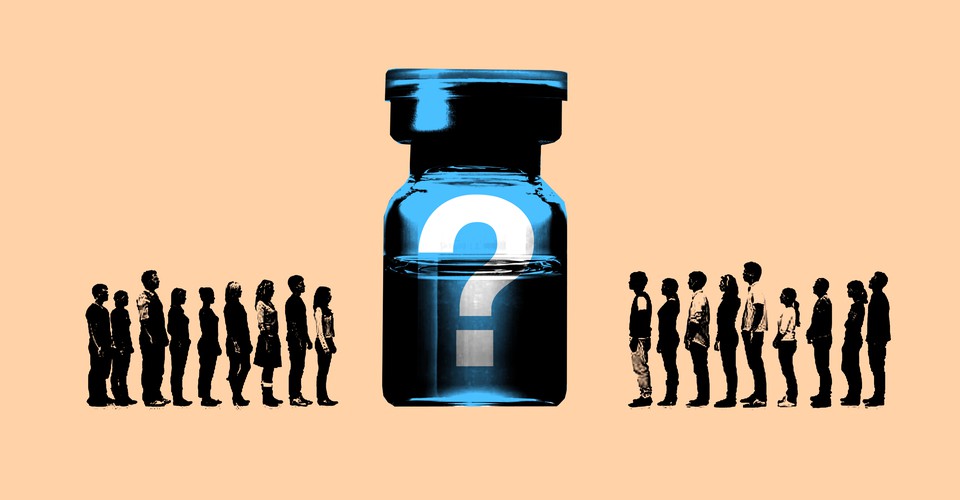Unvaccinated Is Different From Anti-Vax

Last week, CDC Director Rochelle Walensky said that COVID-19 is “becoming a pandemic of the unvaccinated.” President Joe Biden said much the same shortly after. They are technically correct. Even against the fast-spreading Delta variant, the vaccines remain highly effective, and people who haven’t received them are falling sick far more often than those who have. But their vulnerability to COVID-19 is the only thing that unvaccinated people universally share. They are disparate in almost every way that matters, including why they haven’t yet been vaccinated and what it might take to persuade them. “‘The unvaccinated’ are not a monolith of defectors,” Rhea Boyd, a pediatrician and public-health advocate in the San Francisco Bay Area, tweeted on Saturday.
Boyd has been talking to underserved communities about COVID-19 vaccines since November, before any were even formally authorized. Together with several partner organizations, she co-developed a national campaign called The Conversation, in which Black and Latino health-care workers provide information (and dispel misinformation) about the vaccines. She has spoken virtually to dozens of community groups, including churches and schools, fielding their questions about the shots. I reached out to Boyd because I wanted to know what she has learned through all these encounters about why some people are still unvaccinated and what to do about it.
Our conversation has been edited for length and clarity.
Ed Yong: You recently spoke with people in southern Georgia who had many lingering questions about vaccines. On Twitter, you said, “Every question they asked was legitimate and important.” Tell me more about the event and the questions you were getting.
Rhea Boyd: It was a tele-townhall, and around 5,000 people participated. I would have imagined that people who stayed on would be unvaccinated, but the people who asked questions were a mix. I had one gentleman who was vaccinated with Johnson & Johnson and he asked, “Did I get a safe shot?” We affirmed for him that this far after his vaccination, he’s likely safe, but that opened my eyes. If you’ve heard about that serious side effect and are worried if you’re at risk, you’re probably not encouraging the people around you to be vaccinated.
Yong: That’s fascinating to me. There’s a tendency to assume that all vaccinated people are pro-vaccine and all unvaccinated people are anti-vaccine. But your experience suggests that there’s also vaccine hesitancy among vaccinated people.
Boyd: Yes, and we tend to hear similar questions among people who are unvaccinated. They may also have heard common threads of disinformation, but they’re still asking basic questions. The top one is around side effects, which are one of the main things we talk about when we give informed consent for any procedure. If people aren’t sure about that, it’s no wonder they’re still saying no.
A lot of vaccine information isn’t common knowledge. Not everyone has access to Google. This illustrates preexisting fault lines in our health-care system, where resources—including credible information—don’t get to everyone. The information gap is driving the vaccination gap. And language that blames “the unvaccinated” misses that critical point. Black folks are one of the least vaccinated groups, in part because they have the least access to preventive health-care services.
Yong: I’m glad you raised the issue of access. Everyone age 12 and up is now eligible for vaccines, and President Biden promised that 90 percent of people would have a vaccination site within five miles of their home. I’ve heard many people doubt that vaccine access is still an issue and, by extension, that anyone who is still unvaccinated must be hesitant or resistant. Do you disagree?
Boyd: Availability and access aren’t the same thing. If you have to walk the five miles, you’re going to rethink getting vaccinated, especially if you’re elderly, or you have chronic disease, or the round trip is interfering with other things like work. [Much of] our paid workforce doesn’t have flexibility about hours, or couldn’t take a day off if they wanted to. And if you don’t have paid sick leave to deal with the vaccine or the potential side effects of the second dose, you’ll skip it because feeding your family is more important right now.
Child care is also an enormous issue. If you don’t have someone to watch your children, then what do you do? Many of these things the Biden administration has tried to address. They have programs involving Uber and Lyft. Child-care organizations have signed on to help with vaccine appointments. There are tax breaks for companies that offer paid sick leave. These are incredible, but they may not filter down to your area. We need to think about local interventions to help stretch them.
Yong: If these barriers to access were all addressed, do you have a sense of the proportion of people who would then get vaccinated?
Boyd: The truth is we don’t know. If you’re not getting vaccinated, we have even less data on you than if you are vaccinated. But we know that these barriers exist for even basic care. How do we make sense of the fact that some people won’t get critical medications, like their diabetes medications? Or that some people forgo necessary medical care even as they experience complications from chronic illness? It’s not that those individuals don’t want basic medical care! It’s that groups face structural barriers to accessing that care, including rural folks, underinsured folks, and Black folks in particular. Those structural barriers are likely at play for vaccinations too. This is a problem for health care more generally. We’ve been willing to move on without people, while leaving them without resources to fend for themselves.
Yong: What about people at the other extreme, who do have easy access but who are vitriolically opposed to vaccines—people who could more reasonably be described as anti-vaxxers?
Boyd: Anti-vaxxers are incredibly vocal, and because of that, they’ve been a disproportionate focus of our vaccine outreach. But I think that they represent a small part of people in this country, and especially in our communities of color, an irrelevant part. In our work, we haven’t given much credence to their bluster. But the rampant disinformation that’s put out by this minority has shaped our public discourse, and has led to this collective vitriol toward the “unvaccinated” as if they are predominantly a group of anti-vaxxers. The people we’re really trying to move are not.
Yong: I’ve never thought of it that way. We’re used to thinking of anti-vaxxers as sowing distrust about vaccines. But you’re arguing that they’ve also successfully sown distrust about unvaccinated people, many of whom are now harder to reach because they’ve been broadly demonized.
Boyd: Yes. The language we use around unvaccinated people comes with a judgment—a condescension that “you’re unvaccinated and it’s your choice at this point.” That attitude is papering Twitter. It’s repeated by our top public-health officials. They’re railing on the unvaccinated as if they’re holding the rest of us back from normalcy. But unvaccinated people aren’t a random group of defectors who are trying to be deviant. They’re not all anti-vaxxers. They’re our kids! Any child under 12 is in that group.
Yong: Okay, but even if extreme cases are a minority, we can’t ignore them. When I reported on the ongoing surge in Missouri, a hospital chief told me that one patient spat in a nurse’s eye because she told him he had COVID-19 and he didn’t believe her. How do you think about folks who have gotten to that point?
Boyd: These very contentious encounters are driven by people really staunchly holding on to something that they are served by in some way. Maybe it’s the source that belief came from, and they need to believe other things that source says. Maybe they want camaraderie or collegiality with people around them, so they can feel that they’re in an in-group. People need to believe that what they believe is true. They feel threatened when challenged about something to which they feel beholden. The best way to address that may not be to actually challenge them one-on-one, but to shift what people around them are talking about. If you hear enough stories in your Facebook feed or from strangers in the store that reinforce the science, it’ll make what you’re saying less reasonable to you. And less useful to you. And once you don’t need to hold on to it, you can let it go.
Yong: Which is why community-based efforts are so important. People who will be swayed by Anthony Fauci are already listening to him. But, for example, public-health professionals I spoke with in Missouri are trying to get pastors, firefighters, and community leaders to act as trusted voices for their own people.
Boyd: Exactly. At the beginning of the pandemic, we drew on data about how physicians of color were trusted messengers for communities of color. But there are so few of us—only 5 percent of our physician workforce is Black. That isn’t enough. But I think we’re too limited in our thinking about who is a trusted messenger. People use informal communication chains: They have side conversations with the grocery-store clerk, or their niece and nephew. People will believe anecdotal health-care information that their family member suggests over the credible info that a health-care professional is giving.
We’ve talked to virtual faith-based groups on Sundays. We’ve talked to barbershops, after-school organizations, and boys’ and girls’ clubs. Some of these groups are small—hundreds of people, or sometimes just 20. People are then much more specific about their concerns without the things they usually have bluster around. I wonder how many people arrogantly respond about vaccinations during more formal conversations, but then come to our events and share something vulnerable in these protected settings where they’re surrounded by their pastor and people they know.
Yong: This has the added benefit of promoting vaccinations among groups of people who are likely to encounter one another. My concern, however, is that this is slow work—and Delta is moving fast. Does it feel like you’re stuck in a war of attrition against misinformation, while time is running out?
Boyd: It’s true. Now that vaccines aren’t novel, we’ve lost some of that early momentum when people would go to their local Walgreens. Now we have to do the heavy, high-touch work, making sure that we proactively reach out to everyone. And we can only go as fast as people are willing to go.
That’s concerning, and it’s why we need to reimplement mitigation strategies, like indoor masking, in addition to vaccination. That’ll give us the time to do the work. No form of mitigation will block transmission 100 percent, but we have to use them together. When the cavalry arrives, it’s not like all the other soldiers on the field just leave.
Yong: When I talk to people about the vaccination challenge, the main emotions I hear are frustration and despair. So perhaps the most surprising part of this conversation for me is that you sound … hopeful?
Boyd: Yes. I feel enormously hopeful. If I was only going off what I saw online, I’d probably agree that everyone who wasn’t vaccinated is being selfish and difficult. But talking to people like those church groups has changed how I feel completely. Often, I see an entire family on the other side of the screen—kids and grandparents. People come. They come in groups. They’re willing to be vulnerable. They have questions. And their questions are all ones we have answers for. It’s not undoable.


